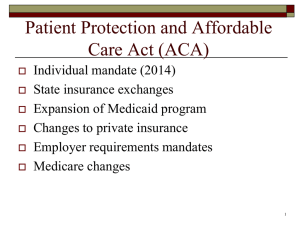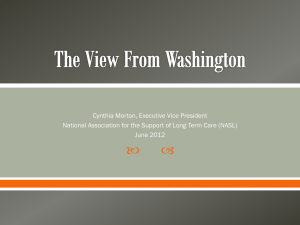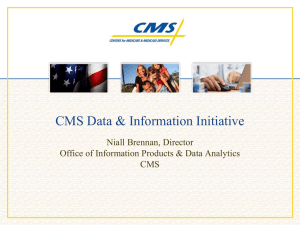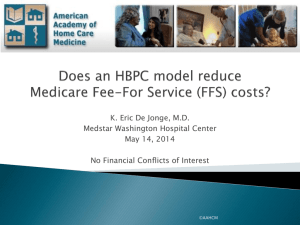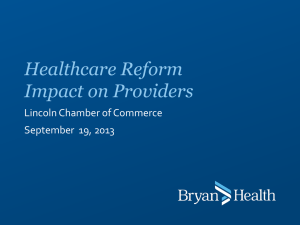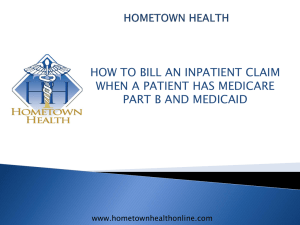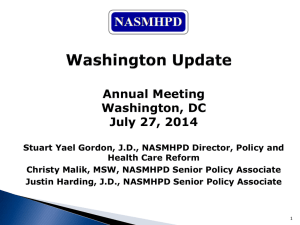Trends & Recent Developments in Healthcare Policy and Enforcement
advertisement
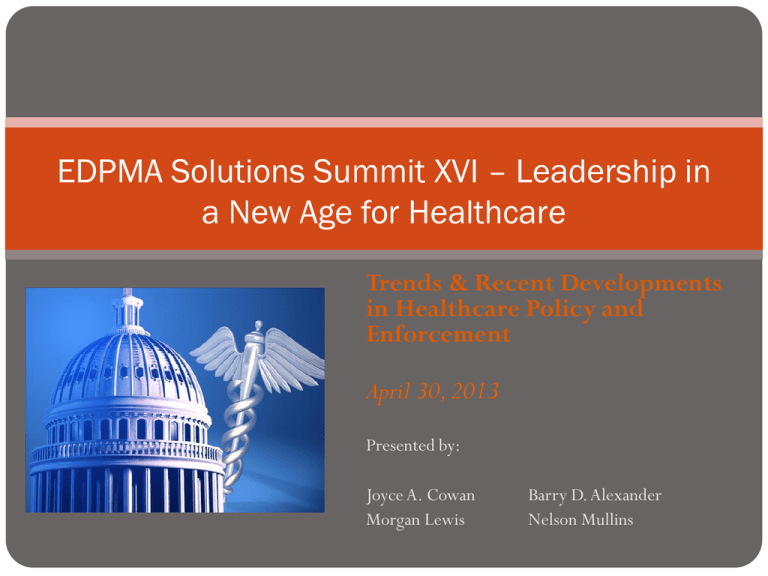
EDPMA Solutions Summit XVI – Leadership in a New Age for Healthcare Trends & Recent Developments in Healthcare Policy and Enforcement April 30, 2013 Presented by: Joyce A. Cowan Morgan Lewis Barry D. Alexander Nelson Mullins Overview ACA Implementation 101 Industry Trends to Watch Challenges Facing the Emergency Medicine Community Ongoing Regulatory Issues Emergency Physicians’ Role in Health Reform Implementation 2 ACA Implementation 101 Health Insurance Exchanges Essential Health Benefits Medicaid Expansion 3 Health Insurance Exchanges Exchanges Marching Forward State Exchanges established (17 states & DC) CA, CO, CT, DC, HI, ID, KY, MD, MA, MN, NV, NM, NY, OR, RI, UT, VT,WA Partnership model – 7 states Federally Facilitated Exchanges: Everyone else Significant Dates October 1, 2013: Open enrollment period begins (through February 28, 2014) January 1, 2014: Coverage sold through Exchanges becomes effective 4 Health Insurance Exchanges – Essential Health Benefits Qualified Health Plans (QHPs) Must Cover: 1. 2. 3. 4. 5. 6. 7. 8. 9. 10. 5 Ambulatory services EMERGENCY SERVICES Hospitalization Maternity & newborn care Mental health and substance abuse disorder services Prescription Drugs Rehabilitative services Lab services Preventive and wellness services Pediatric services, including dental and vision care Health Insurance Exchanges – Essential Health Benefits CMS chose to adopt a state specific approach States may select their benchmark plan from any of the following options: The three largest small group plans in the State The three largest State employee plans The three largest Federal Employees Health Benefits Program (FEHBP) plan options offered to all eligible federal employees; or The HMO with the largest non-Medicaid enrollment in the State 6 Health Insurance Exchanges – Coverage of Emergency Services QHPs must provide coverage of emergency services without imposing any requirement for prior authorization. QHPs cannot place stricter limits on emergency services provided out-of-network than the limits on emergency services provided in-network. 7 Medicaid Expansion 8 Medicaid Pre-2014 - Eligibility varies state to state, many states set income below 100% FPL Medicaid Post-2014 Streamlined eligibility process, coordinated with exchanges States may (Supreme Court 2012 Decision) expand income level for eligibility level up to 138% FPL Feds pay 100% of cost of expansion through 2016 with incremental decrease in matching rate each year until 2020 when the rate is permanently set at 90% Expanding Medicaid (18 States and DC) AZ, CA, CO, CT, DE, DC, FL, HI, IL, MD, MA, MN, NV, NJ, NM, OR, RI, VT, WA Leaning Towards Expanding (7 States) AR, MI, MT, ND, NH, NY, OH Leaning Against Expanding (4 States) AK, KS, VA, WY Undecided (10 States) IN, KY , ME, MO, NE, OK, PA, TN, UT, WV Not Expanding (11 States) AL, GA, ID, IA, LA, MS, NC, SC, SD, TX, WI Medicaid Expansion – Potential Regulatory Changes to Emergency Services Medicaid Eligibility Proposed Rule allows increased cost-sharing for non-emergency use of ED May keep patients with emergent medical needs from coming to the ED Emergency providers lose out on Medicaid reimbursement for the cost-sharing amounts they don’t collect Administrative headache for physicians to chase low-dollar copays ($8 or less) EMTALA screening requirements make it difficult for emergency physicians to direct patients to alternative providers for non-emergent care. Medicaid Eligibility Final Rule Expected -- ? 9 Industry Trends to Watch Fee for Service is Dying a Slow Painful Death The Health Care Arms Race Private-Payer Consolidation Creative Approaches to Provider Integration Bigger is Better When It Comes to Data 10 Fee for Service is Dying a Slow Painful Death 11 • Hundreds of ACOs are off the ground and running (but are they making money--?) • Providers are re-entering the capitation world (Back to the Future). Will they manage risk correctly this time? • Fraud and abuse surveillance is greater than ever. Over $420B collected in 2012! • Groups such as the National Commission on Physician Payment Reform are working to accelerate the transition away from fee-forservice. • Where does that leave Emergency Medicine? If Fee-For-Service is Dying, Where does that leave Emergency Medicine ? A commodity service, slugging it out with payors for compressed reimbursement? A subcontractor to ACOs? An ED led ACO initiative? Looking for a slice of savings But of what—decreased ED visits? From whom? CMS? Commercial Payors? A solution provider? Can the ED be part of the solution, driving patients back into the care pathway ? Is there a win/win model for ED? 12 The Health Care Arms Race • Large health system mergers result in increased bargaining power with payers and providers. But, are ED groups getting any coat-tails or just being asked (demanded) to become PAR with every plan? • Vertical integration between provider groups, hospitals, and post-acute care providers results in more control over care coordination. • Larger systems can reduce their risk exposure as they move towards ACOs, capitated payment arrangements, and other bundled payment structures. • Insurers are using mergers and acquisitions for two reasons • Reestablish negotiating power with larger health systems; • Prepare for an ever shrinking pot of money due to health reform; • Streamline contracting and operational process. 13 The Health Care Arms Race: PrivatePayer Consolidation Larger companies buying smaller companies with substantial Medicare/Medicaid managed care business Too Big to Fail – Health Reform Edition $5.6 billion Aetna-Coventry merger WellPoint’s $4.9 billion acquisition of Amerigroup Cigna’s $3.8 billion purchase of HealthSpring Provider Consolidation & Integration Economies of Scale Better Data 14 Creative Approaches to Provider Integration Consolidation of medical practices is increasing at an exponential pace. In some markets, over 50% of physicians are employed by the hospital or health care system. Many systems believe that they are in a 'life and death' situation in their markets. They must acquire to survive. Most of these deals are losing money on paper on day one. Some hospitals report losses per physician in excess of $300,000 a doctor. On average, they are losing $150K per doctor (but, the good news, they make it up in volume!) Emergence of “new” hospital-physician collaborations including the following: ACO (more than 400 to date, although, many are sitting out of this program) ACO-like structures Co-management structures Professional Services Agreements (PSA) Management Services Agreements (MSA) Hybrid PSA/MSA deals (virtual practice acquisitions) Service-line management agreements Telemedicine solutions EMR integration solutions Independent Practice Associations (IPA) You name it, we are trying it (or doing it again!) 15 Provider Alignment Models Minimum Integration Maximum Integration 16 Cooperative ACO Readiness Assessment 2. Pay for Performance 3. Co-Management of Service Lines 4. PHO or Shared Risk Model 5. Hospital Clinic / PSA Model 6. Hospital Clinic / MSO Model 7. Joint Ventured Physician Organization 8. Medical Foundation Model 9. Tax-Exempt Affiliated Practice Model 10. Hospital Employment Model 1. Challenges for Emergency Medicine in a post-ACA World The Good, the Bad, and the Ugly of Quality Indicators E&M and EHR scrutiny – the saga continues Increased focus on program integrity efforts as HHS increases risk for providers. Asserting a greater role in health reform implementation Potentially heightened risk of malpractice actions as millions of new patients gain access to health insurance coverage. 17 Program Integrity – Increased Risk for Providers The ACA provided additional funding for health care fraud enforcement ACA lowered the standard of intent for Federal Anti- Kickback Statute and False Claims Act violations. ACA lowered the jurisdictional bar for qui tam lawsuits. 18 Fraud & Abuse Enforcement 2012 $4.9B 19 E&M and EHR Scrutiny More stringent RAC Audits of E&M claims due to perceived over- utilization of higher level codes by family practice, internal medicine, and emergency medicine physicians. ZPIC and CERT Audits as well (and sometimes, overlapping and simultaneous) Increased focus on hospitalist coding including initial and subsequent visits placing pressure on documentation systems. Increased auditor scrutiny for pre- and post-payment claims when EHR/EMR templates (or template-driven systems) are used. Check boxes, predefined answers, dropdown menus, or small areas for progress notes are targets for auditors. But, I thought they wanted me to check all systems to improve the quality of care??? 20 And the ALJ Saga Continues… Redetermination and Reconsideration phases continue to be, on many issues, a rubber stamp even though, reconsideration involves a separate qualified independent contractor (QIO) (but, ask yourself, does anyone make money as a contractor reporting back to CMS how many good reviews that the conducted or how many appeals they overturned?) ALJ backlog of cases is now at a record high. Cases are taking a year++ to reach an ALJ (or even scheduling to an ALJ) In Fiscal Year 2012, the number of appeals received by OMHA increased by 119% and in Fiscal Year 2013, the number of appeals received by OMHA increased by 147%. During Fiscal Year 2012, OMHA received 131,735 appeals and decided 64,196 appeals. As of February, 26, 2013, OMHA had 113,761 appeals pending. Currently OMHA has 68 ALJs. 21 Where do we go on the appeal process? Recoupments are permitted to commence after exhaustion of the 2nd level of appeal and there is no "delay at the ALJ" exception. In November of 2012, the OIG issued a critical report of the ALJ process finding that 56% of the appeals making it to the ALJ were overturned in favor of the provider. The OIG concluded that the process needs to be fixed. (We Agree!) In December of 2012, reports leaked that CMS might be seeking some type of legislative action to remove the ALJ and DAB review process relying, exclusively, on some type of contractor level of review process. Really?? All agree that something has to be done—but, what is the thing? 22 Medicare Audit Improvement Act of 2013 Reintroduced on March 19, 2013 by Congressmen Sam Graves (R-MO) and Adam Schiff (D-CA). The bill would amend the Medicare Modernization Act of 2003 ostensibly to rectify problems identified since the creation of the Recovery Audit Contractor (RAC) program. Referred to House Ways and Means Committee and House Energy and Commerce Committee (DOA?) Bill was previously introduced in 2012, but died in committee at the end of the 112th Congress Establishes limit on "additional documentation requests" made to hospitals by Medicare contractors during pre-payment and post-payment audits Imposes financial penalties on Recovery Audit Contractors (RACs) for claim denials overturned on appeal Requires RACs to focus audits on widespread payment errors Requires CMS to post information on its website regarding RAC audit performance Allows denied inpatient claims to be billed as outpatient claims when appropriate Requires physician review of claims denied by RACs for medical necessity 23 Ongoing Regulatory Challenges – Medicare Sustainable Growth Rate (SGR) or “Doc Fix” CMS assumes for the first time that Congress will override the scheduled cuts. Permanent SGR Fix is more likely following the Congressional Budget Office’s (CBO) revision of the cost of a permanent repeal from $244 billion to $138 billion. 24 Health Care Innovation Awards The Health Care Innovation Awards are funding up to $1 billion in grants to applicants who will implement the most compelling new ideas to deliver better health, improved care and lower costs to people enrolled in Medicare, Medicaid and Children's Health Insurance Program (CHIP). Although many awards issued indirectly impact ED care (e.g., by creating preventive programs designed to decrease emergency medical care needs), 4 awards have been issued in the ED space: 25 Health Care Innovation Awards Recipient 26 Project Title Area Award Amount Mount Sinai School of Geriatric emergency department Medicine innovations in care through workforce, informatics, and structural enhancements Illinois, New Jersey, New York $12,728,753 Providence Portland Medical Center Redesigning service delivery through the Tri-County Health Commons Oregon $17,337,093 St. Luke's Regional Medical Center, Ltd. Tele-critical care and emergency services Idaho, Nevada, $11,762,777 Oregon University Emergency Medical Services Better health through social and health care beyond the emergency department New York $2,570,749 Health Care Innovation Awards Mount Sinai School of Medicine Project: Geriatric emergency department innovations in care through workforce, informatics, and structural enhancements Award Amount: $12,728,753 Providence Portland Medical Center Project: Redesigning service delivery through the Tri-County Health Commons Award Amount: $17,337,093 St. Luke's Regional Medical Center, Ltd. Project: Tele-critical care and emergency services Award Amount: $11,762,777 University Emergency Medical Services Project: Better health through social and health care beyond the emergency department Award Amount: $2,570,749 27 2013 & Beyond Issues Impacting ACA Implementation Will employers just drop coverage and pay the penalty? Complex exchange structure – sink or swim? Lack of health care work force to serve influx of new patients. Soaring health care costs for the young and healthy – will this occur? Costs of running exchanges is exceeding estimates. At present, there are not sufficient funds to run all of the state exchanges. The Obama Administration has asked for an extra $1B in funds—but, no guarantee funds will be approved by Congress in the current sequestration environment. 29 Ongoing Regulatory Challenges Sequestration Sequestration No end in sight for 2% cuts to Medicare provider payments under Sequestration. Potential Opportunities for Legislative Action on the Sequester Debt ceiling limit on May 18, 2013 Continuing Resolution funding the government expires September 30, 2013 30 Ongoing Regulatory Challenges – Payment System Reforms Physician Payment Linked to Quality Measures Effective January 1, 2015 Physicians will see their payments modified so that those who provide higher value care will receive higher payments than those who provide lower quality care. Hospital Payment Linked to Quality Measures Hospital Value Based Purchasing Program – effective as of October 1, 2012 Readmissions Reduction Program – effective as of October 1, 2012 Payment adjustment for Hospital Acquired Conditions – effective October 1, 2014 Bundled Payments Impact of bundled payment for other providers on emergency medicine 31 Enhanced Incentive Reward Program and New Enrollment Guidelines On April 24, 2013, CMS issued a proposed rule that would increase incentives for people to report information that leads to a recovery of funds from individuals and entities that have or are engaged in Medicare fraud and abuse. Highlights: CMS is proposing to increase the potential reward amount for information that leads to a recovery of Medicare funds from 10 percent to 15 percent of the final amount collected. The current program caps the reward at $1,000, meaning CMS pays a reward on the first $10,000 it collects as a result of a tip. CMS is also proposing to increase the portion of the recovery on which CMS will pay a reward up to the first $66 million recovered – this means an individual could receive a reward of $9.9 million if CMS recovers $66 million or more. Add the ability to deny the enrollment of providers, suppliers and owners affiliated with an entity that has unpaid Medicare debt. This proposal would prevent individuals and entities from being able to incur substantial debt to Medicare, leave the Medicare program and then re-enroll as a new business to avoid repayment of the outstanding Medicare debt. 32 Enhanced Incentive Reward Program and New Enrollment Guidelines (cont) Deny enrollment or revoke the billing privileges of a provider or supplier if a managing employee has been convicted of certain felony offenses. Permit CMS to revoke billing privileges of providers and suppliers that have a pattern or practice of billing for services that do not meet Medicare requirements. Make the effective date of billing privileges consistent across certain provider and supplier types. CMS is proposing to eliminate ambulance suppliers’ current ability to bill for up to a year prior to enrollment in the Medicare program. CMS is also proposing to require that ambulance providers and other provider and supplier types submit any claims within 60 days of revocation of billing privileges. Limit the use of CAPs to only certain types of enrollment situations not including, for example, failure to report a change in practice location. 33 Role of Emergency Physicians in Health Reform Implementation Emergency physicians have a unique perspective from practicing at the crossroads of healthcare system In-depth understanding of issues with primary care system Gatekeeper role for patients being admitted to hospital Educating policymakers and business leaders is a necessity Emergency physicians will continue to be unfairly targeted in efforts to cut down on readmissions and redirect patients to lower cost care settings unless they advocate their position. 34 Role of Emergency Physicians in Health Reform Implementation Emergency physicians will need to build a data driven narrative to defend against bad policy and go on offense with measures to improve quality and payment. Defining Emergency Physicians’ Place in the Bundle PCPs and Hospitalists are running the show. Emergency physicians need to assert their value and role in new payment models and care systems. Emergency physicians need to begin to see (and promote) the ED as portal to the health care system 35 Questions to Ask your Hospital Partner ? What is your current ACO and physician integration strategy? What is your # 1 pain issue at the hospital in terms of costs or market 36 share? Are you looking at programs that would decrease costs including management agreement structures with physicians? If so, in what departments? Do you have an active wellness program and is there a place for ED medicine in that program? How do you see emergency medicine plugging into your global strategies? Where does telemedicine plug into your system? Is there a role for your ED group in your strategy? How can we help you increase market share? Where are the opportunities? Do not panic. As many talking heads are out there telling people what to do 37 there are an equal number of folks still grasping at straws. While ED does not have a logical seat at the table—in point of fact, the ED is the place where costs savings can be achieved Hospitals are looking to establish 'ED like' facilities from freestanding EDs to urgent care centers that walk right up to the line. Are you involved in these projects? Are you shaping them? Are you just a service vendor? ZPIC, RAC and major DOJ investigations continue to focus on (improper) inpatient admissions—this may place more pressure on observation units and patient management in the ED. The ACA will, if it works, reduce the costs of indigent care losses. Re-thinking of subsidy models including quality driver add-ons and other pieces that plug into the hospital's ACO and other initiatives. Question & Answer Thank You! Joyce A. Cowan – jcowan@morganlewis.com Barry D. Alexander – barry.alexander@nelsonmullins.com 38


